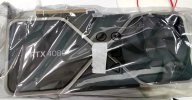Like I said, they still talk about it, but even process names don't refer to nanometers anymore (it's N5 instead of 5nm etc, Intel 7 instead of 10nm and so on)
The little relation "nanometers" still had with reality was lost for good when we moved to finfets. The nm is supposed to refer to smallest feature size, gate length in transistor. There isn't too detailed information on all processes, but 14nm has enough details for 3 manufacturers. Depending on manufacturer "14nm gate length" is actually 18 to 30 nm
That’s been the case for a long time now. But there’s no point in avoiding nm nomenclature until manufacturers stop using it first.




